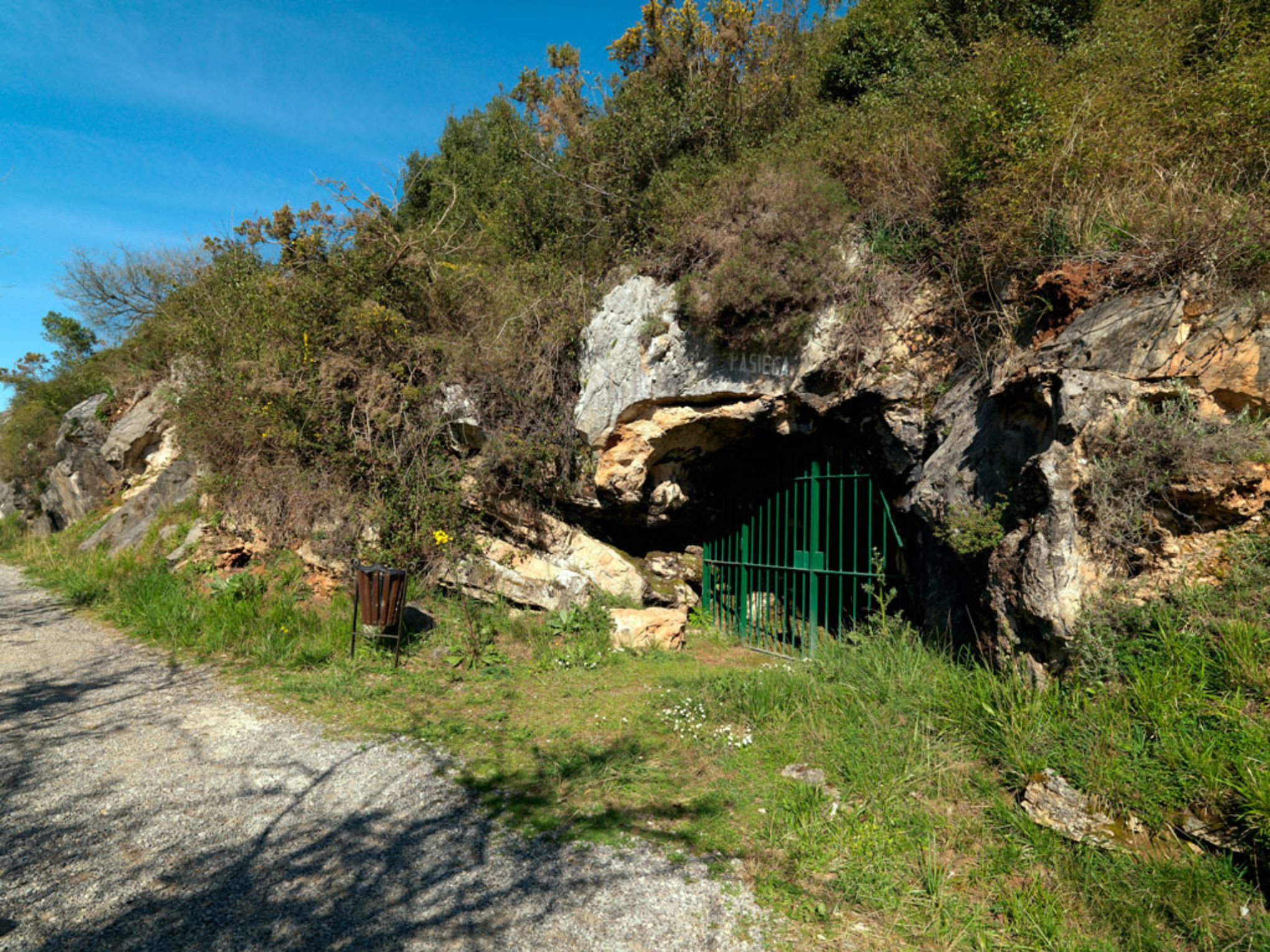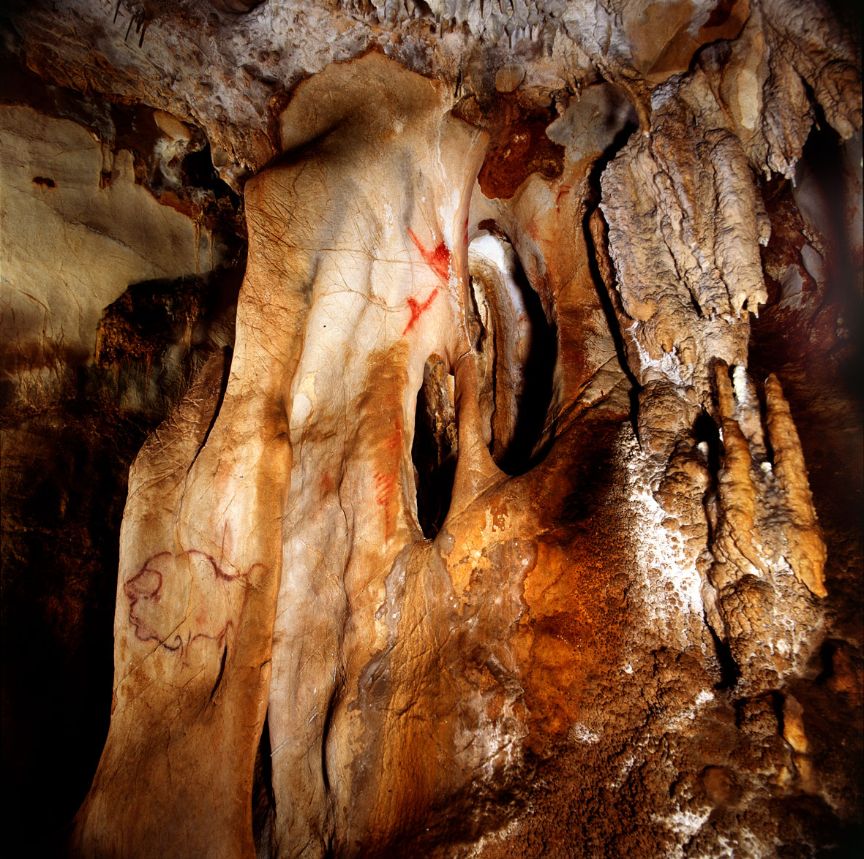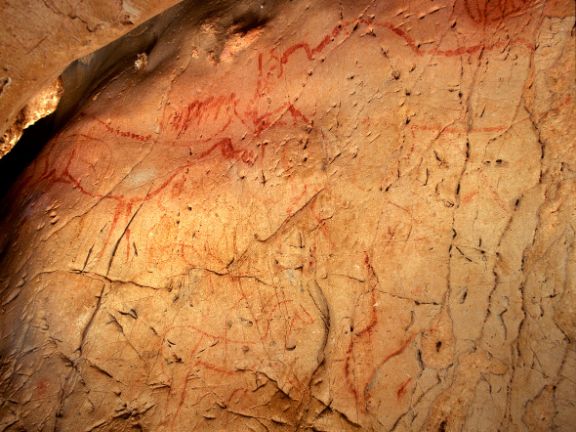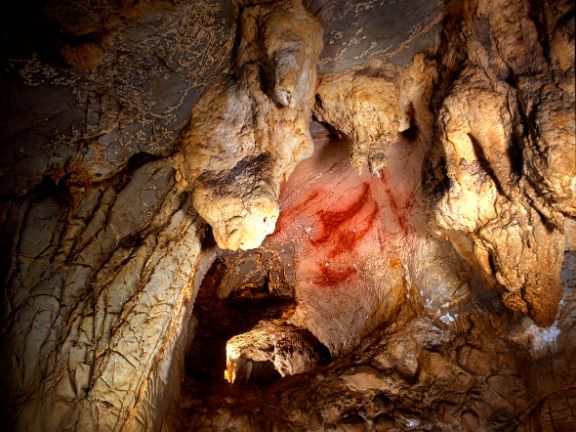La Pasiega Cave

Identification of the Property
SubirMonte Castillo, Puente Viesgo, Autonomous Community of Cantabria
Access
From the N-623 road, turn off in the centre of the town of Puente Viesgo, go past the car park and take the road up the hill to Monte Castillo. This ends at the car park for visitors; from there walk up to reception and the interpretation centre.
Geographical coordinates
UTM 30T 421890E / 4793675N Z: 190
Description
Subir Pulse para ampliar
Pulse para ampliar
Topographic description
Monte Castillo, where the cave is located, is a conical limestone hill, forming the easternmost spur of Sierra del Escudo de Cabuérniga, a feature separating the coastal lowlands from the interior valleys in the west of Cantabria. It stands over the left bank of the River Pas, dominating a wide fluvial plain at the start of the “lower Pas Valley” and also the natural route from this valley to Besaya valley.
La Pasiega Cave is made up of a complex system of chambers and passages heading in different directions and occasionally on different levels. The morphology of the cave has been furthered complicated by building work carried out inside it in the 1950s and 60s in preparation for public visits. Some passages were blocked off by building interior walls, and different entrances were opened. The cave has several natural entrances, facing south, of which at least three (giving access to Galleries B, C and D) could have been in use during the Upper Palaeolithic.
The first sector is about 200m long and consists of Galleries A and B. About 30m to the west of the entrance to this sector is the “old entrance”, which was how the discoverers of the cave made their entry. A further 20m to the west, another entrance leads into Gallery C. The central part of the cave is known as Zone D, and can be reached from any of the entrances. 68 Date of Discovery: The site was discovered in 1911 by H. Obermaier, P. Wernert and H. Alcalde del Río during the course of the excavations at the nearby El Castillo Cave.
Archaeological research
The archaeological deposit was first examined by Obermaier, Wernert and Alcalde del Río between 1911 and 1913. H. Breuil was another participant in the first study of the cave art. In 1951-52, the deposit was dug by J. Carballo and J. González Echegaray, at the same time as the cave was being prepared for tourist visits. The exact stratigraphic sequence is not known, and can be assigned to the Upper Palaeolithic in general. The first digs were in the “old entrance”, whereas in 1951-52 they were at the entrances to Galleries B and C, practically at the foot of the decorated walls, where Solutrean industries were found. New examples of art were found in the second half of the century, and the ensemble was revised by A. LeroiGourhan in the 1960s. Finally, the whole cave has been systematically re-studied by C. González Sainz and R. de Balbín since 1983.
Artistic contents: paintings and engravings
The cave has a very large number of artistic depictions (over 700 figures, signs, and lines and stains of colour) found in all its passages. The densest and best preserved ensemble is found in the last twenty metres of Gallery A and its final narrow bend. It contains animals and signs mostly in red, as well as exceptions in yellow, brown and black and, sporadically, engraved. It is near to being the paradigm of Cantabrian art in the Solutrean-early Magdalenian period, when the region had its own personality different from that of other regions. It has abundant figures of hinds and horses, as well as stags, aurochs, bison, reindeer and ibex. They are reproduced above all in domes and hollows in the roof and wall, generally as simple outlines. An exceptional group of long quadrilateral signs is located in the narrow fissure at the end of the passage.
Gallery B is larger, but more compartmented, with several isolated groups of art, different from each other in their subject matter and techniques. In the area around the original entrance to this gallery, there is a group of large scale aurochs, bison, horses and a megaceros, or giant deer, all painted in red. Near these, and sometimes superimposed on the paintings, there is a group of engravings, particularly of horses, smaller in size but full of precise anatomical details. Whereas the red paintings correspond to the archaic phase of decoration, the engravings are probably Magdalenian in age. Another side of the Gallery has a group of claviforms painted in red, while on yet another wall there is a “symbolic inscription”, a series of abstract signs along a line. Small side-passages and chambers connecting with this Gallery B have groups of animals: stags, horses, hinds and ibex, engraved with simple or repeated lines, frequently striated. Finally, the passage leading to Galleries A and D has a few more animal figures and signs, produced with varied techniques.
The first part of Gallery C, near one of the original entrances, has figures in different styles and techniques, produced in the period between 20,000 and 13,000 B.P, and often superimposed on each other. In addition to the older figures of animals and signs, painted in shades of red, yellow and violet, there is a series of animals that were engraved, painted in black or that are bichrome, and which are more recent. The animals depicted in paint include two hinds facing each other and a large figure of a bison in brown and black. The engravings represent hinds, an ibex and an auroch. At the back of the gallery, a more coherent group of horses, bison and ibex are painted in black or engraved in a Magdalenian style. Passages leading off the gallery have more sporadic groups of figures, such as a splendid engraving of a horse.
Zone D has fewer figures, that are heterogeneous in technique and style, scattered through a very complex part of the cave that was visited less in the Palaeolithic. The first groups, near the junction with Galleries A and B, include painted quadrilateral signs and an engraved horse. A small side-passage has a few 69 Magdalenian-style engravings and a hind in red. Another small chamber in the centre of the maze has several engraved animals associated with pairs of red lines, in a very archaic style. Further chambers have paintings and engravings of horses.
The most recent study, by C. González Sainz and R. de Balbín, has documented a total of 301 animal figures and 148 abstract signs (especially the quadrilateral signs and claviforms) and series of dots. In addition, there are a large number of red stains and non-figurative painted and engraved lines. The most common animals represented are horses and hinds, followed by ibex, stags, bison and aurochs. There are also three anthropomorphs, two reindeer and a megaceros, a carnivore, a bird and a fish, as well as 42 unidentified quadrupeds.
 Pulse para ampliar
Pulse para ampliar
 Pulse para ampliar
Pulse para ampliar
Bibliography
SubirBALBÍN BEHRMANN, R. DE, GONZÁLEZ SAINZ, C. 1992. La Pasiega. Monte de El Castillo, Puente Viesgo, Cantabria. En VV. AA., El nacimiento del arte en Europa (Catálogo de la exposición organizada por la Unión Latina): 239-241. París: Unión Latina.
BREUIL, H., OBERMAIER, H., ALCALDE DEL RÍO, H. 1913. La Pasiega à Puente-Viesgo (Santander) (Espagne). Monaco: Institut de Paléontologie Humaine. Imp. Veuve A. Chêne.
GONZÁLEZ SAINZ, C., BALBÍN BEHRMANN, R. DE 2000. Revisión de las representaciones rupestres paleolíticas de la cueva de La Pasiega en el conjunto del monte Castillo. Topografía y documentación artística. En R. Ontañón Peredo (coord.): Actuaciones Arqueológicas en Cantabria 1984-1999: 69-73. Santander: Consejería de Cultura y Deporte del Gobierno de Cantabria.
LEROI-GOURHAN, A. 1965 (2ª ed. 1971). Préhistoire de l'Art Occidental. Paris: L. Mazenod.
ONTAÑÓN PEREDO, R. 2018. 10 Cuevas Patrimonio Mundial en Cantabria. Santander: Consejería de Educación, Cultura y Deporte - Gobierno de Cantabria / Asociación de Amigos del MUPAC.



